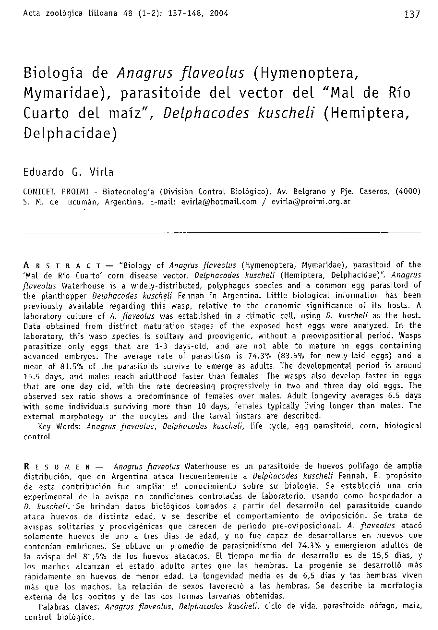Artículo
Biología de Anagrus flaveolus (Hymenoptera, Mymaridae), parasitoide del vector del Mal de Rio Cuarto del maíz, Delphacodes kuscheli (Hemiptera, Delphacidae)
Fecha de publicación:
12/2004
Editorial:
Fundación Miguel Lillo
Revista:
Acta Zoológica Lilloana
ISSN:
0065-1729
Idioma:
Español
Tipo de recurso:
Artículo publicado
Clasificación temática:
Resumen
"Biology of Anagrus flaveolus (Hymenoptera, Mymaridae), parasitoid of the 'Mai de Rio Cuarto' corn disease vector, Delphacodes kuscheli (Hemiptera, Delphacidae)". Anagrus flaveolus Waterhouse is a widely distributed, poiyphagus species and a common egg parasitoid of the planthopper Delphacodes kuscheli Fennah in Argentina. Little biological information has been previously available regarding this wasp, relative to the economic significance of its hosts. A laboratory culture of A. flaveolus was established in a climatic ceil, using D. kuscheli as the host. Data obtained from distinct maturation stages of the exposed host eggs were analyzed. In the laboratory, this wasp species is solitary and proovigenic, without a preovipositional period. Wasps parasitize only eggs that are 1-3 days-old, and are not able to mature in eggs containing advanced embryos. The average rate of parasitism is 74.3% (83.5% for newly-laid eggs) and a mean of 81.5% of the parasitoids survive to emerge as adults. The developmental period is around 15.5 days, and males reach adulthood faster than females. The wasps also develop faster in eggs that are one day old, with the rate decreasing progressively in two and three day old eggs. The observed sex ratio shows a predominance of females over males. Adult Longevity averages 6.5 days with some individuals surviving more than 10 days, females typically Living longer than males. The external morphology of the oocytes and the larval instars are described
Archivos asociados
Licencia
Identificadores
Colecciones
Articulos(PROIMI)
Articulos de PLANTA PILOTO DE PROC.IND.MICROBIOLOGICOS (I)
Articulos de PLANTA PILOTO DE PROC.IND.MICROBIOLOGICOS (I)
Citación
Virla, Eduardo Gabriel; Biología de Anagrus flaveolus (Hymenoptera, Mymaridae), parasitoide del vector del Mal de Rio Cuarto del maíz, Delphacodes kuscheli (Hemiptera, Delphacidae); Fundación Miguel Lillo; Acta Zoológica Lilloana; 47; 12-2004; 137-148
Compartir




